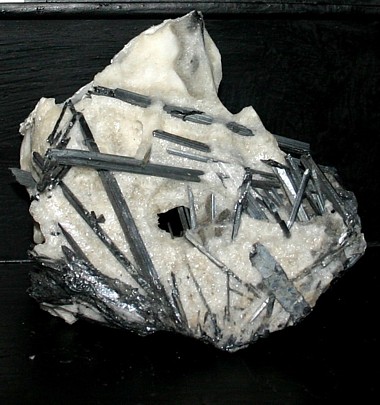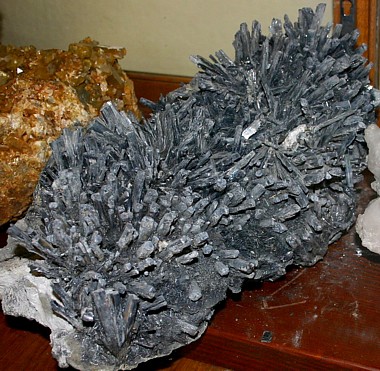|
.
Stibnite Mineral Facts:
Chemical Formula: Sb2S3
- 71.4 % Antimony by weight
Colors:
Mineral and streak are
lead-gray.
In very thin splinters
it is translucent in red or yellow tints.
Hardness:
2.0
Density:
4.55
Cleavage:
One cleavage that is
very perfect parallel (010), leaving striated surfaces.
Crystallography: Orthorhombic
Slender prismatic habit, prism zone vertically striated. Crystals often
steeply terminated, and often in radiating groups. Crystals sometimes
curved or bent. Crystals of stibnite are often very
complicated, and rendered that way by
the great number of their terminal planes.
Many
of
the crystals of this mineral, more particularly those with
an acicular habit, are
curved, bent or twisted. Nearly all, whether curved or straight, are
longitudinally striated.
Luster:.
Metallic luster,
slightly transparent on very thin sections.
Optics:
(Refractive Index): a = 4.303; y = 3.194
|
 |
|
Composition,
Structure and Associated Minerals:
Stibnite is the commonest and the most important ore of antimony. As
found, however, it usually contains small quantities of iron and often
traces of
silver
and gold.
Surfaces that are exposed
to the air are often coated with a black or an
iridescent tarnish. It is a
nonconductor of electricity.
Identification and Diagnostics
Stibnite is
characterized by its bladed structure, perfect cleavage in one direction,
its lead-gray color and soft black streak.
It fuses very easily, thin
splinters being melted even in the flame of a candle.
When
heated on charcoal the mineral yields antimony and sulfurous fumes, the
former of which coat the charcoal white in the vicinity of the assay. Stibnite may easily be
distinguished from all minerals but the other
sulfides by the test
for sulfur. From the other sulfides it is distinguished by its cleavage and
the fumes it yields when heated on charcoal. Its closest resemblance is with
galena, which, however, differs from it in being less fusible and
in yielding a lead globule when fused with sodium carbonate on charcoal.
Moreover, galena possesses a cubic cleavage.
Occurrence,
Localities and Origins:
Stibnite is deposited by alkaline
waters in connection usually with
quartz. Found
as crystals in quartz
veins cutting crystalline rocks or beds in
granite and gneiss. Associated with other antimony minerals, as the products
of its decomposition, and with
sphalerite,
galena,
cinnabar,
barite and
sometimes
gold. Found in various mining districts in Saxony, and Bohemia,
Mexico, New South Wales, China, etc. Occurs in magnificent crystals in
Province of lyo, Island of Shikoku, Japan. Found in quantity only sparingly in
the United States, the chief deposits being in California, Nevada and Idaho.
The mineral occurs also in York Co.,
New
Brunswick, in Rawdon township, Nova
Scotia, at many
points in the eastern United States, in Sevier Co.,
Arkansas, in Garfield
Co., Utah, and at many of the mining districts in
the Rocky Mountain
States.
In Arkansas stibnite is in quartz veins
following the bedding planes
of shales and sandstones. With
it are found many lead, zinc and
iron compounds and small quantities of rarer
substances. In Utah the mineral occurs in veins unmixed with other minerals,
except its own oxidation products. The veins follow the bedding of
sandstones and conglomerates. Here, as in Arkansas, the stibnite is believed
to have been deposited by magmatic waters.
Antimony is chiefly valuable as an
alloy with other metals. With tin and lead it forms type metal. The
principal alloys with tin are britannia metal and pewter. With lead, tin and
copper it constitutes babbit metal, a hard alloy used in the construction of
locomotive and car journals, and with other substances it enters into the
composition of other alloys used for a variety of purposes, including
bullets and wheel weights.
Return to the
Mineral Collectors Information Page |

Stibnite Crystals |
|



